 | |
| Location | Teramo |
|---|---|
| Type | Art museum |
Museo Civico di Teramo (Italian for Civic Museum of Teramo) is an art museum in Teramo, Abruzzo. [1]
 | |
| Location | Teramo |
|---|---|
| Type | Art museum |
Museo Civico di Teramo (Italian for Civic Museum of Teramo) is an art museum in Teramo, Abruzzo. [1]
The museum collections mainly derived from suppressed ecclesiastic institutions during the years 1868 and 1888. Initially, the works were displayed in a palace next to the church of Sant'Anna. The discovery of ancient Roman items in town, expanded the collections.
Among the works on display are: [2]
Coordinates: 42°39′42″N13°41′51″E / 42.6618°N 13.6976°E
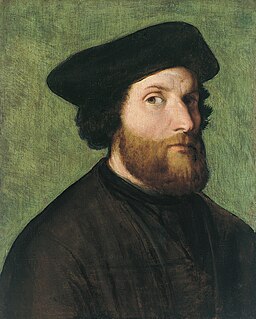
Lorenzo Lotto was an Italian painter, draughtsman and illustrator, traditionally placed in the Venetian school, though much of his career was spent in other north Italian cities. He painted mainly altarpieces, religious subjects and portraits. He was active during the High Renaissance and the first half of the Mannerist period, but his work maintained a generally similar High Renaissance style throughout his career, although his nervous and eccentric posings and distortions represented a transitional stage to the Florentine and Roman Mannerists.
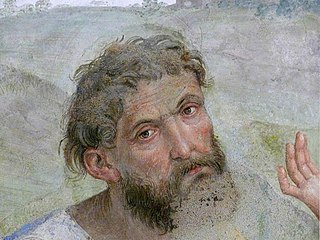
Lo Spagna, "the Spaniard" in Italian, was a painter of the High Renaissance, active in central Italy. His name was Giovanni di Pietro, but he was known as Lo Spagna because he was born in Spain. After Raphael, he was a main pupil and follower of the Umbrian painter Perugino, whose style his paintings develop. He should not be confused with Pietro di Giovanni D'Ambrogio of Siena.

Lorenzo di Credi was an Italian Renaissance painter and sculptor best known for his paintings of religious subjects. He is most famous for having worked in the studio of Andrea del Verrocchio at the same time as the young Leonardo da Vinci.

Carlo Cignani was an Italian painter. His innovative style referred to as his 'new manner' introduced a reflective, intimate mood of painting and presaged the later pictures of Guido Reni and Guercino, as well as those of Simone Cantarini. This gentle manner marked a break with the more energetic style of earlier Bolognese classicism of the Bolognese School of painting.

Simone Cantarini or Simone da Pesaro, called il Pesarese was an Italian painter and etcher. He is mainly known for his history paintings and portraits executed in an original style, which united aspects of Bolognese classicism with a bold naturalism.

Castello Ursino, also known as Castello Svevo di Catania, is a castle in Catania, Sicily, southern Italy. It was built in the 13th century as a royal castle of the Kingdom of Sicily, and is mostly known for its role in the Sicilian Vespers, when it became the seat of the Sicilian Parliament. The castle is in good condition today, and it is open to the public as a museum.

Giovanni Antonio Boltraffio was an Italian painter of the High Renaissance from Lombardy, who worked in the studio of Leonardo da Vinci. Boltraffio and Bernardino Luini are the strongest artistic personalities to emerge from Leonardo's studio. According to Giorgio Vasari, he was of an aristocratic family and was born in Milan.

Altobello Melone was an Italian painter of the Renaissance.
The decade of the 1460s in art involved some significant events.

Cesare Gennari was an Italian painter of the Baroque period. His Saint Mary Magdalene is in the Pinacoteca Civica di Cento. His Apparition of the Virgin to Saint Nicholas of Bari is at the Pinacoteca di Bologna.
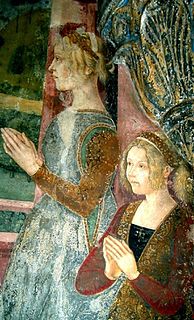
Maestro della Cappella di Santa Margherita a Crea, or more simply Maestro di Crea, is the name given to the anonymous Italian painter who was engaged by Guglielmo VIII Paleologo, Marquis of Montferrat, to decorate the chapel of Santa Margherita in the Santuario della Madonna di Crea near Serralunga di Crea. The work was performed during the years 1474–1479. The sanctuary stands on the highest hill of the Basso Monferrato; later it would form the focal pont of the Sacro Monte di Crea.

Egidio De Maulo was an Italian painter mainly of landscapes and still lifes.
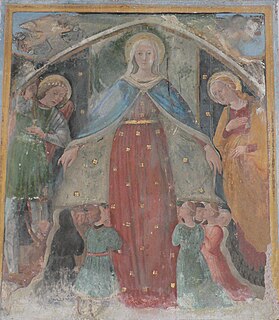
Giovanni Angelo d'Antonio was an Italian Renaissance painter belonging to the Camerino school that also included Giovanni Boccati and Girolamo di Giovanni.
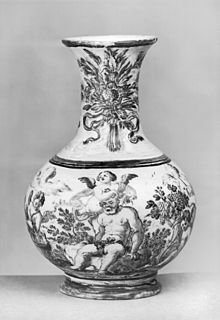
Francesco Antonio Xaverio Grue (1686–1746) was an Italian potter and painter.

The Master of Pratovecchio was an Italian painter of the Renaissance, named by Roberto Longhi in a 1952 article on the basis of stylistic similarities of a number of works to an altarpiece painted for the monastery of San Giovanni Evangelista in Pratovecchio. The centre panel of the triptych, depicting the Assumption of the Virgin is currently on deposit in Arrezo; the left and right side-panels are in the National Gallery, London.
The Gazzola Institute is a school of the arts and art museum, located on via Gazzola n°9 in the town of Piacenza, region of Emilia Romagna, Italy.
The Master of Staffolo was an anonymous late-Gothic style painter active in the region of Marche and Umbria.

The Museo Civico di Montepulciano, also known as the Museo Civico Pinacoteca Crociani, is the town or comune art gallery and museum. It is housed in the medieval Palazzo Neri Orselli, a 14th-century structure located on Via Ricci #10, corner with Via Talosa, in the center of the town of Montepulciano, in the Province of Siena, region of Tuscany, Italy. The museum was founded in 1954.

The Pinacoteca Civica di Palazzo Volpi is the town art gallery on Via Diaz 84 in the town of Como, Lombardy, Italy. It is housed in the 17th-century Palazzo Volpi.
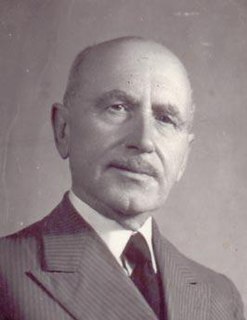
Raffaello Celommi was an Italian genre and seascape painter.